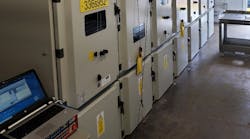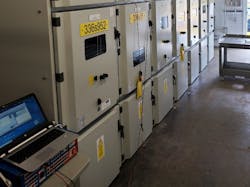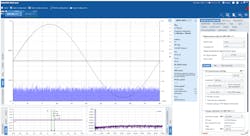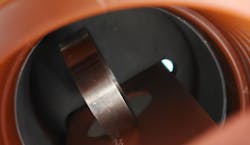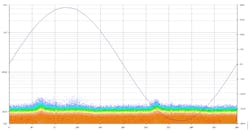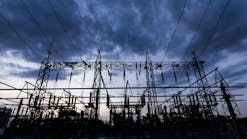Onsite Partial Discharge Measurement During Commissioning: Safe From the Start
Partial discharge (PD) measurement has been used for several decades to assess the condition of high voltage (HV) and medium voltage (MV) electrical apparatus. In the past, the application was mostly performed during the production stages of different assets (e.g., during R&D, factory type tests and factory acceptance tests).
Nowadays, the test is increasingly also applied to several apparatus during onsite commissioning, periodic maintenance and for monitoring.
This article, which is co-authored by Omicron and Advanced Electrical Services (AES), shares a recent experience of onsite commissioning of a MV air-insulated switchgear. It exposes the benefits of PD measurements as an onsite diagnostic test and highlights the advantages of using an advanced partial discharge measuring system to enhance, facilitate and accelerate the analysis of PD data.
The COVID-19 pandemic has pushed the power industry to innovate and redefine what we called our work environment. The most common way of doing so is to increase the capabilities of employees to work remotely, in order to reduce typical crowded workspaces. However, there are many aspects of the industry which still require ‘boots on the ground’ to ensure that the physical work is being completed. Thus, for many people who work on maintaining the critical power industry assets, working remotely is usually not an option.
In April 2020, Advanced electrical services (AES) received a contract to perform the commissioning of a newly installed 27.5 kV air-insulated switchgear (Figure 1), located in Nisku, Alberta. AES is a NETA accredited company headquartered in Calgary, Alberta, and provides medium voltage (MV) & high voltage (HV) commissioning services throughout Western Canada. In this case, the commissioning was to be performed according to the NETA Standards. In addition, it included offline partial discharge measurements.
Partial discharge is defined as a localized dielectric breakdown of a small portion of an insulating material. They happen when the local electric field exceeds the local dielectric strength of the insulation. When a PD event occurs, a current pulse of a short duration (in the nanoseconds range) is generated. This current pulse can be measured using different kinds of sensors. In many cases, PD are detectable at the early stage of the insulation deterioration process. Therefore, PD measurements are suitable to provide an early warning to operators and allow time to plan corrective actions when needed. For this reason, PD measurements are commonly performed on several apparatus such as rotating machines, transformers, cables, instrument transformers and switchgear. Figure 2 shows a schematic of a typical PD measurement setup according to IEC60270.
For AES, this commissioning contract was an excellent opportunity to try the newly released OMICRON MPD800 partial discharge measurement system. In order to take full advantage of the advanced functions of the new MPD800 system, they asked the onsite support of OMICRON. However, due to increasing travel and safety restrictions that were being implemented across many Canadian provinces and regions, OMICRON application engineers would not be able to go onsite.
OMICRON is committed to help its customers. This includes providing support to the power industry in ways we never thought we would explore. After evaluating the situation and discussing with AES management, it was agreed that a remote PD measurement would take place. However, there is always a safety hazard regarding the use of a high-voltage source to energize the test object, especially in these unusual circumstances. In this specific case, the maximum test voltage was 30kV AC. AES already had tremendous experience with medium and high voltage testing of switchgear, including air-insulated, vacuum and GIS. Therefore, all parties involved felt comfortable to go ahead with the remote testing session. The newly released OMICRON MPD800 partial discharge system would be shipped to site and the test would be conducted by the onsite AES personnel with the live virtual support of OMICRON’s application engineers. This solution allowed the test to take place without increasing the risk of transmission of the novel virus.
The equipment was received approximately one week prior to the scheduled testing date. This allowed OMICRON’s application engineers to provide an initial training regarding the new MPD800. It was very important that the onsite personnel felt comfortable with the equipment. To this extent, the new MPD software is well suited. A customized profile was created for that specific application, enabling the visualization of only the functions the operator would require during the test and therefore, avoid any confusion.
On the first day of the onsite testing, several performance and safety checks were completed. Using those, it was quickly determined that one of the cables from the high-voltage source had partial discharges and, would need to be replaced for the measurement. Once completed, the actual testing of the switchgear could begin.
Prior to the PD measurements, the switchgear had successfully passed an AC dielectric withstand test or commonly referred to ‘Hipot’ test. However, during the initial PD measurements, high PD levels were measured on all three phases at a voltage of approximately 5 kV. Being connected remotely allowed a fast response and analysis of the phase-resolved partial discharge (PRPD) diagram. The conclusion was that some conductive parts were left at floating potential inside the switchgear. This means that those conductive objects are neither insulated nor grounded properly.
On the first day of the onsite testing, several performance and safety checks were completed. Using those, it was quickly determined that one of the cables from the high-voltage source had partial discharges and, would need to be replaced for the measurement. Once completed, the actual testing of the switchgear could begin.
Prior to the PD measurements, the switchgear had successfully passed an AC dielectric withstand test or commonly referred to ‘Hipot’ test. However, during the initial PD measurements, high PD levels were measured on all three phases at a voltage of approximately 5 kV. Being connected remotely allowed a fast response and analysis of the phase-resolved partial discharge (PRPD) diagram. The conclusion was that some conductive parts were left at floating potential inside the switchgear. This means that those conductive objects are neither insulated nor grounded properly.
To locate the source of those partial discharges, it was decided to isolate and test different areas of the switchgear by opening and closing some of the breakers. This process of elimination helped to narrow down the search area to the main bus compartment. At this point, a visual inspection was required to verify the findings of the PD measurements. After opening and inspecting the switchgear, the experienced AES team quickly found several anomalies inside the main bus compartment.
Many pieces of hardware used for the assembly were left uninstalled inside the switchgear along with a pair of electrical pliers. In addition, there were some critical errors found with the switchgear assembly such as unconnected corona rings. These findings confirmed the initial diagnostic obtain from the PRPD analysis. The pieces of hardware were removed, and the corona rings were connected according to the manufacturer’s specifications. Afterwards, the PD measurements were repeated, and all PD apparent charge levels were below 100 pC, which was the passing criteria at a voltage of 19 kV.
These types of anomalies are commonly found in air-insulated switchgear after onsite assembly. Unfortunately, they are too often only detected by visual inspection several years after the original commissioning due to obvious signs of deterioration, or in the worst case, after a failure. Traditionally, the AC dielectric withstand test is the only onsite insulation test that is performed on those assets and will only detect major defects. Objects left behind can cause partial discharges that will over time, deteriorate the insulation and create abnormal amount of ozone. This can eventually damage the equipment or lead to in-service failure with significant economic losses, or more importantly, be a considerable risk to the health and safety of onsite personnel.
Partial discharge measurements can be used to assess the insulation of different medium voltage and high-voltage apparatus. OMICRON’s PD testing solutions provide users with a high-end and robust systems. The customizable profiles also allow the users to optimize their testing experience based on their specific application. With 20 years of experience in the field of PD testing on medium-voltage and high-voltage assets, OMICRON will continue to provide innovative solutions not only for its products, but also to provide essential support to its customers worldwide in this difficult time.
Acknowledgments
The authors would like to thank the AES onsite personnel for their support during those measurements; Joshua Blanchette, Stive Hailu and Zak Houk.
